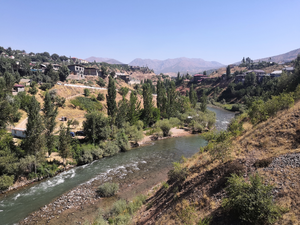Roughness coefficient: различия между версиями
Evg Fil (обсуждение | вклад) |
Evg Fil (обсуждение | вклад) |
||
| (не показано 7 промежуточных версий этого же участника) | |||
| Строка 1: | Строка 1: | ||
| − | [[Файл:Mountain river.png|мини| | + | [[Файл:Mountain river.png|мини|Горная река]] |
==Коэффициент шероховатости== | ==Коэффициент шероховатости== | ||
| − | Коэффициент, который характеризует шероховатость поверхности русла или трубы, вмещающей воду, и который учитывается при расчете сопротивления потока в русле или трубе.<ref name=":0">WMO W.M.O., UNESCO U.N.E. and S.O. International Glossary of Hydrology. – 1998. – 461 | + | Коэффициент, который характеризует шероховатость поверхности русла или трубы, вмещающей воду, и который учитывается при расчете сопротивления потока в русле или трубе.<ref name=":0">WMO W.M.O., UNESCO U.N.E. and S.O. International Glossary of Hydrology. – 1998. – 461 pp.</ref> |
==Определение на английском== | ==Определение на английском== | ||
Coefficient that characterizes the roughness of a water carrying channel or a pipe and which is taken into account when computing the resistance to flow in the channel or pipe.<ref name=":0" /> | Coefficient that characterizes the roughness of a water carrying channel or a pipe and which is taken into account when computing the resistance to flow in the channel or pipe.<ref name=":0" /> | ||
| − | Numerical measure of the frictional resistance to flow in a river channel<ref>Goudie A. Alphabetical Glossary of Geomorphology // International Association of Geomorphologists. – 2014. – | + | Numerical measure of the frictional resistance to flow in a river channel<ref>Goudie A. Alphabetical Glossary of Geomorphology // International Association of Geomorphologists. – 2014. – PP. 84.</ref> |
==Пример использования на английском языке== | ==Пример использования на английском языке== | ||
| − | In rivers, the most common calibration parameter is the roughness coefficient, that accounts for the friction term.<ref>Ferreira D.M., Fernandes C.V.S., Kaviski E., Bleninger T. Calibration of river hydrodynamic models: Analysis from the dynamic component in roughness coefficients // Journal of Hydrology. – 2021. – Т. 598. – | + | In rivers, the most common calibration parameter is the roughness coefficient, that accounts for the friction term.<ref>Ferreira D.M., Fernandes C.V.S., Kaviski E., Bleninger T. Calibration of river hydrodynamic models: Analysis from the dynamic component in roughness coefficients // Journal of Hydrology. – 2021. – Т. 598. – PP. 126-136.</ref> |
| − | + | Manning's roughness coefficient was estimated for a gravel-bed river reach using field measurements of water level and discharge, and the applicability of various methods used for estimation of the roughness coefficient was evaluated.<ref name=":1">Kim J.S., Lee C.J., Kim W., Kim Y.J. Roughness coefficient and its uncertainty in gravel-bed river // Water Science and Engineering. – 2010. – Т. 3. – № 2.</ref> | |
| − | + | For this reason, uncertainty related to the roughness coefficient was analyzed in terms of change in computed variables.<ref name=":1" /> | |
==Перевод на русский== | ==Перевод на русский== | ||
В реках наиболее распространенным калибровочным параметром является коэффициент шероховатости, который учитывает коэффициент трения. | В реках наиболее распространенным калибровочным параметром является коэффициент шероховатости, который учитывает коэффициент трения. | ||
| − | Коэффициент шероховатости | + | Коэффициент шероховатости Мэннинга был рассчитан для галечно-валунного русла с использованием полевых измерений уровня и расхода воды, а также была проведена оценка применимости различных методов, используемых для определения коэффициента шероховатости. |
| − | + | Поэтому неопределенность, связанная с коэффициентом шероховатости, была проанализирована с точки зрения изменения расчетных переменных. | |
==Список литературы== | ==Список литературы== | ||
<references /> | <references /> | ||
Текущая версия на 14:09, 26 апреля 2024
Коэффициент шероховатости
Коэффициент, который характеризует шероховатость поверхности русла или трубы, вмещающей воду, и который учитывается при расчете сопротивления потока в русле или трубе.[1]
Определение на английском
Coefficient that characterizes the roughness of a water carrying channel or a pipe and which is taken into account when computing the resistance to flow in the channel or pipe.[1]
Numerical measure of the frictional resistance to flow in a river channel[2]
Пример использования на английском языке
In rivers, the most common calibration parameter is the roughness coefficient, that accounts for the friction term.[3]
Manning's roughness coefficient was estimated for a gravel-bed river reach using field measurements of water level and discharge, and the applicability of various methods used for estimation of the roughness coefficient was evaluated.[4]
For this reason, uncertainty related to the roughness coefficient was analyzed in terms of change in computed variables.[4]
Перевод на русский
В реках наиболее распространенным калибровочным параметром является коэффициент шероховатости, который учитывает коэффициент трения.
Коэффициент шероховатости Мэннинга был рассчитан для галечно-валунного русла с использованием полевых измерений уровня и расхода воды, а также была проведена оценка применимости различных методов, используемых для определения коэффициента шероховатости.
Поэтому неопределенность, связанная с коэффициентом шероховатости, была проанализирована с точки зрения изменения расчетных переменных.
Список литературы
- ↑ 1,0 1,1 WMO W.M.O., UNESCO U.N.E. and S.O. International Glossary of Hydrology. – 1998. – 461 pp.
- ↑ Goudie A. Alphabetical Glossary of Geomorphology // International Association of Geomorphologists. – 2014. – PP. 84.
- ↑ Ferreira D.M., Fernandes C.V.S., Kaviski E., Bleninger T. Calibration of river hydrodynamic models: Analysis from the dynamic component in roughness coefficients // Journal of Hydrology. – 2021. – Т. 598. – PP. 126-136.
- ↑ 4,0 4,1 Kim J.S., Lee C.J., Kim W., Kim Y.J. Roughness coefficient and its uncertainty in gravel-bed river // Water Science and Engineering. – 2010. – Т. 3. – № 2.
